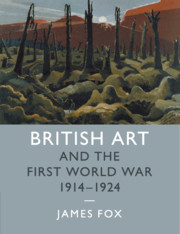Book contents
- Frontmatter
- Contents
- List of plates
- List of figures
- Acknowledgements
- Introduction
- 1 The outbreak of war and the business of art
- 2 Perceptions of art
- 3 The arts mobilize
- 4 War pictures: truth, fiction, function
- 5 Peace pictures: escapism, consolation, catharsis
- 6 Art and society after the war
- Conclusion
- Notes
- Bibliography
- Index
- Index
3 - The arts mobilize
Published online by Cambridge University Press: 05 August 2015
- Frontmatter
- Contents
- List of plates
- List of figures
- Acknowledgements
- Introduction
- 1 The outbreak of war and the business of art
- 2 Perceptions of art
- 3 The arts mobilize
- 4 War pictures: truth, fiction, function
- 5 Peace pictures: escapism, consolation, catharsis
- 6 Art and society after the war
- Conclusion
- Notes
- Bibliography
- Index
- Index
Summary
As we have so far seen, the early part of the war marginalized, impoverished and demonized Britain's art world. Within less than a year of the conflict's start, art was not only struggling to be commercially feasible; its established place in British life was under threat. In a despairing 1915 essay in the International Journal of Ethics, Clive Bell expressed a genuine fear that the nation was about to abandon art for ever. ‘From every quarter’, he claimed, ‘comes the same cry – “This is no time for art!”’ Nevertheless, it was at this point that the art world finally started to take matters into its own hands. By the beginning of 1915 artists and art institutions had come to two realizations: their own adherence to ‘business as usual’ was failing, and the war was not going to end quickly. It became clear that if they were to survive the conflict's indefinite hardships they needed to adapt to wartime conditions and prove they were no less patriotic – and no less useful – than the rest of society. Many concluded that the best way to do this was not to compete with the war effort, but to mobilize behind it.
It is now well established that the First World War – like all ‘total wars’ – was fought as much on the home front as it was on the front line. John Horne has written that after 1914 ‘all kinds of social groups and institutions mobilized themselves behind the war effort, and in doing so contributed powerfully to a cultural fusion, or at least convergence, in defence of state and nation’. This chapter describes how, amid the many obstacles that it faced, the art world embarked on its own mobilization for war. Exhibiting societies transformed themselves into nationalistic institutions; the art market devoted itself to charitable initiatives; museums became organs of state-issued directives; and artists rallied the home front precisely as they calibrated the front line. As its hitherto private activities took on explicitly public functions, the art world became an increasingly important tool in the waging of the conflict. In the process, it not only neutralized and inverted many of the criticisms that had previously been made of the arts; it went some way towards securing a place for itself in the mainstream of British society.
- Type
- Chapter
- Information
- British Art and the First World War, 1914–1924 , pp. 55 - 81Publisher: Cambridge University PressPrint publication year: 2015



